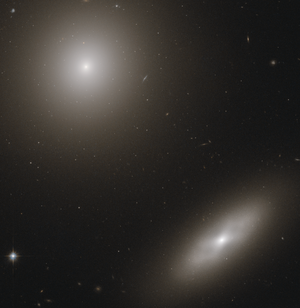NGC 1375
| Galaxy NGC 1375 |
|
|---|---|

|
|
| NGC 1374 (top left) and NGC 1375 (bottom right) in a photo taken by the Hubble Space Telescope | |
| AladinLite | |
| Constellation | Chemical furnace |
|
Position equinox : J2000.0 , epoch : J2000.0 |
|
| Right ascension | 03 h 35 m 16.8 s |
| declination | -35 ° 15 ′ 57 ″ |
| Appearance | |
| Morphological type | SAB0 ^ 0 ^: / Edge-On |
| Brightness (visual) | 12.2 mag |
| Brightness (B-band) | 13.2 mag |
| Angular expansion | 2.3 ′ × 0.9 ′ |
| Position angle | 91 ° |
| Surface brightness | 12.8 mag / arcmin² |
| Physical data | |
| Affiliation | Fornax cluster |
| Redshift | 0.002468 +/- 0.000020 |
| Radial velocity | 740 +/- 6 km / s |
|
Stroke distance v rad / H 0 |
(28 ± 2) x 10 6 ly (8.47 ± 0.60) Mpc |
| history | |
| discovery | John Herschel |
| Discovery date | November 29, 1837 |
| Catalog names | |
| NGC 1375 • PGC 13266 • ESO 358-024 • MCG -06-08-030 • 2MASX J03351683-3515564 • SGC 33321-3525.9 • AM 0333-352 • FCC 148 • LDCE 249 NED019 | |
NGC 1375 is a lenticular galaxy of Hubble type SB0 in the constellation Fornax the southern sky , the 28 million light-years from an estimated Milky Way is removed. It is listed as a member of the Fornax galaxy cluster under catalog number FCC 148 .
The galaxies NGC 1373 , NGC 1374 , NGC 1378 , NGC 1379 are located in the same area of the sky .
The object was discovered on November 29, 1837 by the astronomer John Herschel with a 48 cm telescope.
Web links
Commons : NGC 1375 - collection of images, videos, and audio files
